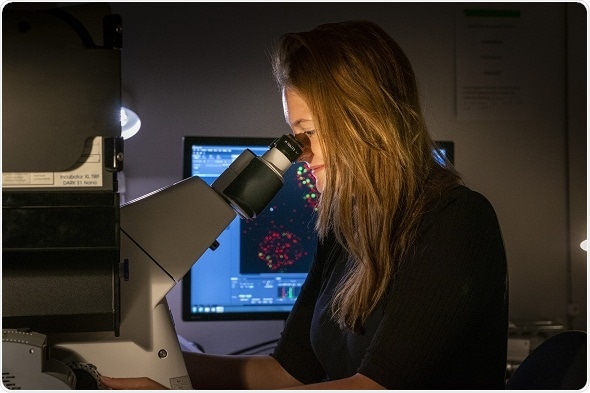
Researchers discover how the body repairs damaged DNA
Researchers from the University of Copenhagen have made an extraordinary discovery in how the body repairs damaged DNA, which can lead to better understanding and management of diseases such as cancer.

After several years of an intensive study, researchers from the Novo Nordisk Foundation Center for Protein Research at the University of Copenhagen have discovered how proteins stabilize damaged DNA and thereby preserve DNA function and integrity of our bodies.
The new finding also helps explain why people with inherited or acquired defects in certain proteins cannot keep their DNA stable and develop diseases, such as cancer. Faulty DNA is a fundamental cause of most cancers.
In short, two proteins called 53BP1 and RIF1 engage to build a three-dimensional ‘scaffold’ around the broken DNA strands. This scaffold then locally concentrates special repair proteins, that are in short supply, and that are critically needed to repair damaged DNA without mistakes.
Technology enabled findings
The ground-breaking research was only possible thanks to close partnership of researchers at the University of Copenhagen with their colleagues at the University of Oxford and European Biology Laboratory in Heidelberg, who together combined a unique set of expertise and high-end technologies including super-resolution microscopy.
“Super-resolution microscopy enabled us to zoom in on living cells and visualize objects about the size of one-thousandth of the width of a hair and follow how the protein scaffold assembles and grows around the DNA fracture. You can compare it to putting a plaster cast on a broken leg; it stabilizes the fracture and prevents the damage from getting worse and reaching the point where it can no longer heal,” said Fena Ochs, Postdoc and study author from the Novo Nordisk Foundation Center for Protein Research at the University of Copenhagen.
Ongoing cancer research
One of the most notable benefits of basic research such as the new study is that it provides scientists with molecular tools to simulate, and thus better understand, conditions that happen during development of a real disease.
And it’s not the first time that the University of Copenhagen have made ground-breaking discoveries on DNA and cancer.
Last year a team from the Novo Nordisk Foundation Center for Protein Research published another study into DNA repair illuminating why some breast cancer patients respond to treatment and others do not. The previous study uncovered a new 'protein shield' that aids in repairing damaged DNA in cells and affects resistance to drugs used for breast cancer treatment. The new study now provides an unexpected angle to this discovery and explain how this protein shield works in its ‘natural habitat’ – the nucleus of a human cell. This opens up previously unforeseen opportunities to better predict therapy of some types of cancer based on knowledge-based molecular diagnostics.
The Novo Nordisk Foundation Center for Protein Research has recently been awarded a 700 million Danish Kroner grant (around £80 million) by the Novo Nordisk Foundation for further research over the next five years.
The new study on ‘Stabilization of chromatin topology safeguards genome integrity’ was published this week in the renowned scientific journal ‘Nature’.
Next steps are to look more in-depth at identifying all the relevant proteins that repair the DNA damage with the view of creating appropriate drug resistance longer term.
No comments:
Post a Comment